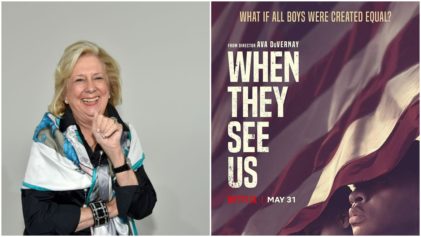
Too often, diversity programs and initiatives sound far too often like window dressing and tokenism, “feel good” exercises that fail to address the root of the problem, which is systemic exclusion and discrimination, but rather cause gatekeepers to feel as if they have accomplished something, and lull “diverse” people into the false notion that progress has been made. There needs to be an examination of how these systems, professions, and industries work to the detriment of Black people and others.
As Leah Chernikoff wrote in Elle magazine, when asked if there is a need for women’s media, she responded yes, “as long as women make up only 20 percent of Congress, as long as senior movie studio execs are 93 percent male, and only four percent of studio films are directed by women; as long as the President of the United States, the VP, the Speaker of the House, the President Pro Tem, the Secretaries of State, of the Treasury, of Defense, are all men.” She noted that Ava Duvernay, the director of Selma, does not care for the word diversity, a term that feels emotionally disconnected, more like medicine, as opposed to inclusion and belonging, and welcoming people.
Duvernay, whose distribution company supports Black independent films and films for people of color “made by directors who are outside the center of Hollywood”— is not pleased with the fact that she is one of only two women who directed a top 100 grossing film last year. She believes that as we fight for equality, we have to look inward and value ourselves. We must also support, nourish and uplift each other, welcome people into the community, seek each other out for new business opportunities, and not allow our total existence to be dominated by thoughts of who does not value us.
Further, looking at television, in the 2014-15 season, there were 13 Black female characters in prime time, according to the Pittsburgh Post-Gazette. Meanwhile, there were only four Latina and Asian characters and one qualifying as “other,” as 78 white female characters appeared in prime time.
Erica Baker, a Slack build and release engineer, speaks of the woes in the tech industry, as Black women represent less than five percent of employees at Apple, Google, Facebook, Microsoft, Intel and other tech giants. She has focused on the inadequacy of diversity initiatives that target “women in tech” as failing to address the pitifully low numbers of Black, Latino and Asian employees at major tech firms. Baker attended a conference on the achievements of women in the tech industry, yet there were two white male keynote speakers and no women of color, and the sponsor of the conference as no Black women on its board. Baker, who wants to highlight the achievements of Black women, laments the lack of intersectionality in tech companies’ diversity efforts, a type of “colorless diversity” where we are told “get in line people of color… wait for (white) women to get theirs, then we’ll get to you.”
Writing for InformationWeek, David Wagner points to the failure of efforts such as Facebook’s TechPrep diversity program—which is designed for people interested in programming and to help parents to get their children interested in tech–as proof that the tech sector must look in the mirror and change its culture. He argues there needs to be “an effort to build a culture of acceptance, opportunity, equality, and continued inspiration” in order to retain talent, and the emphasis should be on IT firms spending more time keeping the women and minorities they have rather than simply inspiring new people to get into tech, in order to build the number of role models and inspire a new generation.
Wagner noted that 4.5 percent of all new bachelor’s degree recipients in computer science or computer engineering from top research universities were Black and 6.5 percent were Latino, according to a USA Today. Yet, only 2 percent of Silicon Valley workers are Black, and 3 percent are Latino, which means more people of color are inspired to get degrees in IT than are working in the industry. Further, women in IT are 45 percent more likely to leave the field than men.
Meanwhile, Gene Robertson, professor emeritus at the University of Missouri, wrote in the Missourian that diversity training does not adequately address systemic racism at the university. He argues that classes on diversity may cover up, and even increase the racism that already exists.
Robertson argues that “the way to address racial disparity at this institution is to first do a systemic analysis of the entire institution and its programs to determine modes, patterns and places of discrimination. Diversity training is only a Band-Aid gesture” that only “temporarily masks the cancer of racist attitudes, behaviors and conditions that permeate MU.” He adds that racism existed on the campus long before any Black students enrolled there, and it will take more than a simple course to address pervasive behaviors resulting from decades-long patterns of discrimination, inequities and injustices piled on people of color. The professor says that to address racism at the institution, there must be a forthright examination of policies, practices and behaviors that impact minorities, and if they are causing inequities or discomfort based on race, religion or another basis.
The consequences of societal exclusion are grave and sobering. Consider the legal profession, which is the least diverse profession in the nation. According to the U.S. Labor Department, 88 percent of all lawyers are white, while women are one-fifth of law firm partners, and people of color are under 7 percent of law firm partners and 9 percent of general counsels of large corporations. In addition, only 3 percent of associates and fewer than 2 percent of partners are Black at major law firms. At the same time, Paulette Brown, the first Black woman to become president of the American Bar Association, said that “We need to know that diversity can never be numbers alone.” She added, “It’s critically important to improve the numbers, but real diversity is achieved when diverse employees feel valued and included in their organization.” Brown noted the role of implicit bias in creating inequality in the legal profession and in the criminal justice system, and links that to the lack of confidence among Blacks and Latinos in the system.
As the U.S. becomes a majority Black and Brown nation by 2043–with the nation’s Latino and Asian populations surpassing 54 million and 19.4 million, respectively–this reality is not reflected in the newsrooms of this nation, which remain largely white, as reported in the International Business Times. In 2014, the share of people of color and women at newspapers remained “relatively steady” at 12 percent, according to the American Society of Newspaper Editors (ASNE), which tracks newsroom diversity. This includes 4.74 percent Black, 4.19 percent Latino, 2.8 percent Asian-American and less than half of a percent Native American.
By focusing on diversity rather than looking at the elephant in the room, we will fool ourselves into thinking that the problem is solved, when in reality no progress has been made.


